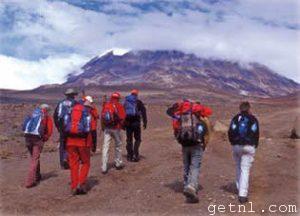
Those who climb Mount Stanley are promised a breathtaking variety of flora, fauna, and terrain that puts Africa’s more famous giant, Mount Kilimanjaro, to shame
NEED TO KNOW
LOCATION Mount Stanley lies in Rwenzori National Park, on the border between Uganda and the Democratic Republic of Congo
HIGHEST POINT 16,763 ft (5,109 m)
FIRST CLIMBED In 1906, by the Italian mountaineer and prince Luigi Amedeo CLIMBERS PER YEAR Fewer than 1,000
Explorers returning from Africa to Europe in the mid-19th century were met with scepticism when they claimed to have seen ice and snow atop Mount Kilimanjaro and Mount Kenya, both of which stand just miles from the equator. But by the time the British explorer Henry Morton Stanley returned home in 1889 with tales of a dazzling set of six glaciated summits in central Africa’s Rwenzori Mountains – the tallest of which was named Mount Stanley in his honor – the extraordinary reality began to sink in.
Today, thousands of people travel to Africa’s equatorial peaks for their challenging climbs, picturesque scenery, and to experience the strange existence of near-Arctic conditions in the tropics.
But while some 20,000 people flock to fabled Mount Kilimanjaro every year, fewer than 1,000 people visit Mount Stanley, which boasts all the majesty, much more wildlife, and none of the crowds of its more famous rival.
One of the most spectacular features of tropical mountains is the wealth of different ecosystems and extraordinary biodiversity found on their slopes. Mount Stanley is no exception. You’ll climb from rain forest and moorland up to mossy forests and bogs, and finally onto glaciated alpine terrain. The mountain’s abundant rainfall gives rise to weird and wonderful plants, including heather that grows up to 20 ft (6 m) high and giant groundsels and lobelia, which look more like miniature trees than ground cover.
Wildlife-spotting on Mount Stanley is also superb, and far superior to that of Mount Kilimanjaro. Over 70 mammal species inhabit the Rwenzori Mountains, including colobus and blue monkeys, which chatter in the forest canopies, bushbucks and antelopes, which graze near lakes and meadows, and mountain elephants, golden cats, and leopards. And nearly 200 species of endemic and migratory birds, from colorful turacos to bee-eaters, reside in the lowland jungles.
The terrain on Mount Stanley, Africa’s third highest peak, is tougher than that found on either Mount Kilimanjaro or Mount Kenya. The Rwenzori Mountains – also known as “The Mountains of the Moon” because of their rocky white peaks – are sliced with deep-cut gorges, rivers, and ravines.
Once you get near the summit, you’ll need to rope up and use an ice ax and crampons to traverse the Elena Glacier, before making the final push toward the summit. In addition to the challenging landscape, be prepared for more rain and lower visibility than you might find on other African peaks, along with some dicey river crossings and knee-deep mud. But the rewards are spectacular. The mountain’s tricky terrain and near-constant wet weather explain why this UNESCO World Heritage Site is so unspoiled, lush, and full of life.
PRACTICAL INFORMATION
Getting There and Around
The Rwenzori Mountains are best accessed from Kasese in southwest Uganda, which is about 185 miles (300 km) – or a 5- to 6-hour journey on paved roads – from Kampala’s Entebbe International Airport.
From Kasese, you can arrange your trek into Rwenzori National Park, which will include an ascent of Mount Stanley.
Where to Eat
Meals included in trekking packages to the Rwenzori Mountains.
Where to Stay
Accommodations also comes part and parcel with your trekking package, and are usually in simple wooden huts along the circuit.
When to Go
Due to its equatorial setting, Mount Stanley can be climbed at any time of year, but July to mid-September and December to February do offer slightly drier conditions.
Budget per Day for Two
An eight-day guided trek in the Rwenzori Mountains, including a climb of Mount Stanley, meals, accommodations, and porters is about US$750 for two people.
FORGET MOUNT KILIMANJARO?
THE BUILD-UP Mount Kilimanjaro, which is the highest peak in Africa, is the tallest mountain in the world that is accessible to hikers, and requires no technical mountaineering expertise. Rising above the Serengeti, the broad, snowcapped summit is an alluring fixture on the horizon throughout much of Kenya and Tanzania. And the opportunity to visit some of Africa’s finest game parks before climbing the fabled mountain has undeniable appeal.
THE LETDOWN The major ascent routes are consistently crowded, and on the most popular of these, dubbed the “Coca-Cola Route,” you’ll find camps selling drinks and snacks. Wildlife sightings, even at lower levels, are rare and the terrain at higher levels is often less than picturesque. There are many inexperienced climbers here who shortcut acclimatization, are unfit for the challenge, and never see the summit.
GOING ANYWAY? If seeing Mount Kilimanjaro’s steadily shrinking glacier before it disappears is still on your must-do list, make sure you go with a reputable operator that is committed to your safety and the fair treatment of porters. These operators are likely to recommend less-congested routes offering gradual acclimatization and, therefore, a better chance of summit success